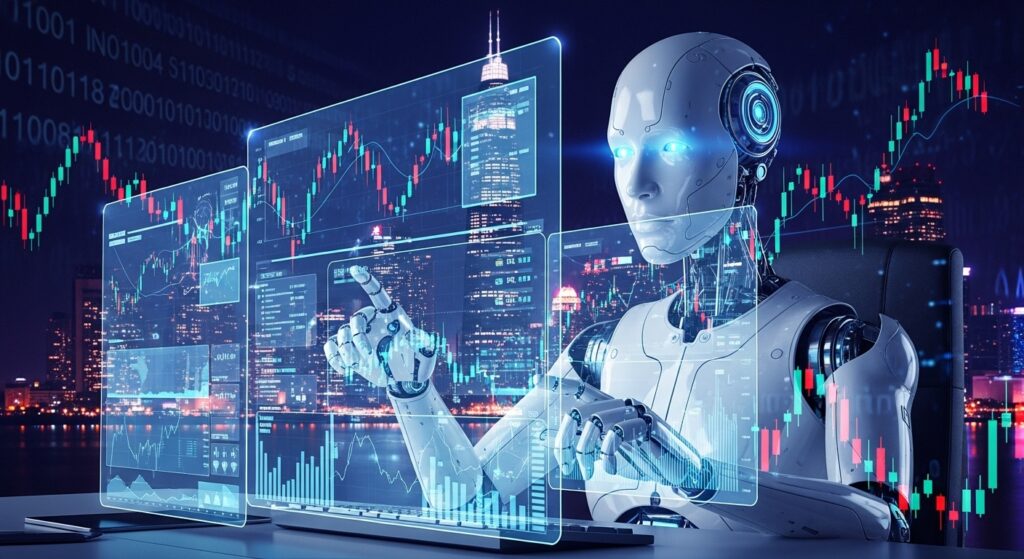Cryptocurrency trading is fast and unpredictable. Prices can shift in seconds, making it hard to keep up. Artificial Intelligence (AI) is changing this by helping traders make smarter, faster decisions. AI can analyze huge amounts of data, automate trades, and reduce emotional errors. This overview explains how to use AI for crypto trading in 2025. It covers tools, strategies, risks, and practical steps to get started. Whether you’re new to crypto or a seasoned trader.
What is AI in Crypto Trading?
AI, or Artificial Intelligence, lets machines learn from data and make decisions. In crypto trading, AI analyzes market data, predicts price movements, and executes trades. It uses several technologies:
- Machine Learning (ML): Learns from past data to predict future prices.
- Natural Language Processing (NLP): Analyzes news, social media, and other text to gauge market sentiment.
- Reinforcement Learning: Improves trading strategies by learning from results over time.
AI makes trading faster and more accurate. It removes emotions like fear or greed, which often lead to mistakes. For example, an AI bot can spot a price trend and act instantly, unlike a human who might hesitate.
Benefits of Using AI for Crypto Trading
AI offers clear advantages for crypto traders:
- Automation: Trades 24/7 without needing constant attention.
- Data Analysis: Processes large datasets to find patterns humans might miss.
- Risk Management: Sets stop-loss orders and adjusts strategies to limit losses.
- Portfolio Optimization: Rebalances investments to match your goals.
- Emotion-Free Trading: Makes decisions based on data, not feelings.
These benefits help traders stay competitive in the volatile crypto market. For instance, AI can monitor Bitcoin prices while you sleep, ensuring you don’t miss opportunities.
How AI-Powered Trading Bots Work

AI trading bots are programs that use algorithms to trade automatically. Here’s how they operate:
- Data Collection: Bots gather data from historical prices, real-time market updates, and news.
- Analysis: AI algorithms identify patterns and trends in the data.
- Decision Making: Bots decide when to buy or sell based on the analysis.
- Execution: They place trades on exchanges using APIs (application programming interfaces).
Bots use various strategies, including:
- Trend-Following: Buying when prices rise and selling when they fall.
- Mean Reversion: Buying low and selling high, expecting prices to return to average.
- Sentiment-Based: Trading based on market mood from news or social media.
- High-Frequency Trading: Making many small trades to profit from tiny price changes.
For example, a bot might buy Ethereum when its price dips below a certain level and sell when it rises, based on historical patterns.
Choosing the Right AI Trading Platform
Selecting a platform is key to successful AI trading. Consider these factors:
- Reliability: Look for platforms with strong user reviews and a proven track record.
- Features: Ensure it offers backtesting, paper trading, and risk management tools.
- Ease of Use: Beginners should choose user-friendly interfaces.
- Cost: Check for subscription or trading fees.
Popular platforms in 2025 include:
- 3Commas: Offers various bots and a simple interface (3Commas).
- Cryptohopper: A cloud-based bot with a strategy marketplace (Cryptohopper).
- Shrimpy: Focuses on portfolio management and supports multiple exchanges (Shrimpy).
Compare platforms to find one that matches your trading style and budget.
Setting Up and Using AI for Crypto Trading

Here’s a step-by-step guide to start AI trading:
- Choose a Platform: Select a trusted platform like 3Commas or Cryptohopper.
- Set Up an Account: Create an account and connect it to your crypto exchange (e.g., Binance or Coinbase).
- Define Your Strategy: Set rules for buying and selling, like price thresholds or indicators.
- Backtest Your Strategy: Test it on historical data to check performance.
- Paper Trade: Practice with virtual money to refine your approach.
- Go Live: Start trading with real money, beginning with a small amount.
Monitor your bot regularly and tweak strategies as markets change. For example, if a bot loses money in a volatile market, adjust its risk settings.
Risks and Limitations of AI in Crypto Trading
AI trading has risks to consider:
- Overfitting: A strategy may work well on past data but fail in live markets.
- Poor Data Quality: Bad data leads to bad decisions.
- Regulatory Concerns: Laws on AI trading vary by country, so check local rules.
- Market Volatility: Sudden price swings can challenge even the best AI models.
To manage risks, use high-quality data, test strategies thoroughly, and stay informed about regulations. Never rely on AI alone—always review its performance.
AI-Powered Crypto Wallets
AI is also used in crypto wallets, combining storage with smart features:
- Predictive Analytics: Suggests buy or sell actions based on market trends.
- Enhanced Security: Detects unusual activity to protect funds.
- Real-Time Notifications: Alerts you to price changes or security issues.
However, AI wallets rely on internet connections and may raise privacy concerns. Choose a wallet with strong security features to protect your assets.
Future Trends in AI and Crypto Trading
AI in crypto trading is evolving. Key trends for 2025 include:
- Quantum Computing: Could improve data analysis speed and accuracy.
- DeFi Integration: AI will support decentralized finance tasks like yield farming.
- Accessibility: User-friendly tools will make AI trading available to more people.
These trends suggest AI will become even more important for crypto traders in the future.
FAQs
Here are answers to common questions:
- What is the best AI for crypto trading?
It depends on your needs. 3Commas, Cryptohopper, and Shrimpy are popular choices (Bitdegree). - Can AI predict crypto prices accurately?
AI can spot trends, but crypto markets are unpredictable. No tool guarantees perfect predictions (Coinbureau). - Is AI trading safe for beginners?
Yes, if you start small, use paper trading, and choose a trusted platform (Kraken). - How much does an AI trading bot cost?
Costs vary. Some platforms offer free plans, while others charge monthly fees (Koinly). - Are there legal issues with AI trading?
Laws differ by country. Check local regulations or consult a legal expert (Bitdegree).
Conclusion
AI is changing crypto trading by making it faster, smarter, and less emotional. It offers tools for automation, data analysis, and risk management. However, it’s not a magic solution. Risks like overfitting, poor data, and market volatility require careful planning. By choosing a reliable platform, testing strategies, and staying informed, you can use AI to improve your trading. Keep learning and trade responsibly to make the most of AI in 2025.

